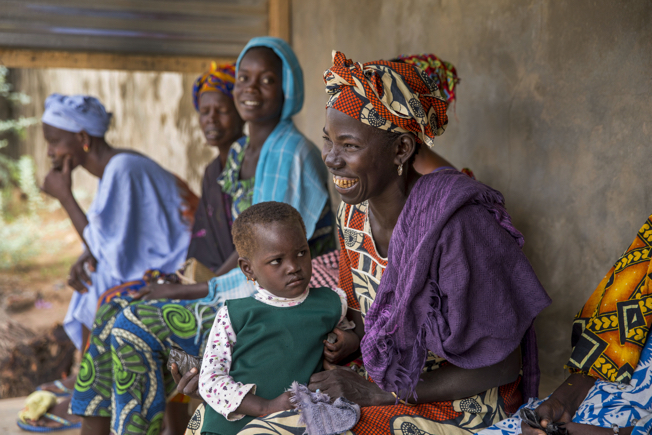A woman smiles during a visit from a Marie Stopes International mobile clincial outreach team in Laniar, Senegal. (Photo Credit: Jonathan Torgovnik/ Reportage by Getty Images, licensed under CC BY NC 4.0)
We live in an increasingly visual world. A hundred hours of video are uploaded to YouTube every minute. Over 20 billion photos have been shared on Instagram to date, and one in four teens consider it their favorite social network. So if pictures were valuable before, today they are critical for communicating and connecting with others.
Yet I was struck by how few compelling images I could find that tell the stories of our international reproductive health grantees. They’re doing amazing work—from providing services to women living in remote areas in sub-Saharan Africa to empowering young people to take charge of their sexuality and reproductive health. But coming up with just six photos to include on the Hewlett Foundation website last year was a far harder task than I thought it would be.
And what photos I could find were focused on the need for the grantees’ services rather than the impact of their work. Instead of women waiting in long lines for reproductive health services or empty shelves where contraceptive supplies should be, we wanted to show the transformative power that family planning can have on women’s lives. Queues and stock-outs certainly are the reality on the ground and challenges that must be addressed. But photos can do more than document a challenge. They can inspire. We wanted photos that would inspire policymakers to support these services, and that would inspire women and girls to seek out and demand better care. We needed photos that show what empowerment looks like.
That’s why we commissioned Getty Images to travel to Kenya, Uganda, and Senegal last summer to document the work of a number of our grantees in pictures. The results—some 400 openly licensed images—speak for themselves. And because they’re openly licensed and have full releases from all subjects, anyone is free to download and share them.
Here are just a few examples.
A woman laughs during a visit from a Marie Stopes International mobile clincial outreach team in Laniar, Senegal. (Photo Credit: Jonathan Torgovnik/ Reportage by Getty Images, licensed under CC BY NC 4.0)
This woman’s laughter as she’s waiting at a clinic with her child, and her beaming smile, tell me she’s genuinely happy to be there. We speak a lot about voluntary services in our field, about the importance of choice. Pictures like these really bring that home, in a way that reading a report about how providers are ensuring quality services simply can’t.
Community outreach services—providing services closer to where women live—are considered a best practice. But we don’t often get to see these interactions between community health providers and the women they serve. It’s touching to see these relationships up close, to be a part of these important, intimate conversations. I am grateful that these brave women let a stranger wielding a camera into their lives this way. I hope these images will convey the value of ensuring access in even the most remote areas, of speaking with individual women about their lives and needs, and of offering them choices.
Women participate in the Tostan Community Empowerment Program in Sahre Bocar, Senegal. (Photo Credit: Jonathan Torgovnik/ Reportage by Getty Images, licensed under CC BY NC 4.0)
A community health worker visits a woman in her home to discuss family planning services in Mbale, Ugandal. (Photo Credit: Jonathan Torgovnik/ Reportage by Getty Images, licensed under CC BY NC 4.0)
A community mobilizer visits a member of the Help Women Group Alita Kole in Ayala, Uganda. (Photo Credit: Jonathan Torgovnik/ Reportage by Getty Images, licensed under CC BY NC 4.0)
Our grantees are helping women and their families achieve their full potential by addressing a clear need: reproductive health. These pictures show that they are helping to build a community of shared understanding and mutual support. And it’s clear that giving women the chance to exercise reproductive choice is one way to empower them.
There are many intractable challenges that remain in our field. But being able to imagine—and see—the possibilities provide a reason to continue the work. If we’re trying to convince other people, from policymakers to women not currently using modern contraception why reproductive health is good and important, these pictures go a lot further than any amount of written words could.
An outreach worker discusses family planning options with young women from the Baroma school in Busia, Uganda. (Photo Credit: Jonathan Torgovnik/ Reportage by Getty Images, licensed under CC BY NC 4.0)
Members of a young mothers group supported by DSW (Desutsche Stiftung Weltbevoelkerung) during a self-empowerment session in Nairobi, Kenya. (Photo Credit: Jonathan Torgovnik/ Reportage by Getty Images, licensed under CC BY NC 4.0)









